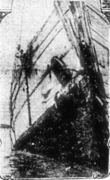
RMS Empress of Ireland was a British-built ocean liner that sank near the mouth of the Saint Lawrence River in Canada following a collision in thick fog with the Norwegian collier Storstad in the early hours of 29 May 1914. Although the ship was equipped with watertight compartments and, in the aftermath of the Titanic disaster two years earlier, carried more than enough lifeboats for all aboard, she foundered in only 14 minutes. Of the 1,477 people on board, 1,012 died, making it the worst peacetime maritime disaster in Canadian history.

RMS Laconia was a Cunard ocean liner, built by Swan, Hunter & Wigham Richardson as a successor of the 1911–1917 Laconia. The new ship was launched on 9 April 1921, and made her maiden voyage on 25 May 1922 from Southampton to New York City. At the outbreak of the Second World War she was converted into an armed merchant cruiser, and later a troopship. She was sunk in the South Atlantic Ocean on 12 September 1942 by torpedoes. Like her predecessor, sunk during the First World War, this Laconia was also destroyed by a German submarine. Some estimates of the death toll have suggested that over 1,658 people were killed when the Laconia sank. The U-boat commander Werner Hartenstein then staged a dramatic effort to rescue the passengers and the crew of Laconia, which involved additional German U-boats and became known as the Laconia incident.

Eurana was a steam cargo ship built on speculation in 1915 by Union Iron Works of San Francisco. While under construction, the ship was acquired by Frank Duncan McPherson Strachan to operate in the Atlantic trade for his family's Strachan Shipping Company. The vessel made several trips between the Southeast of the United States and Europe before being sold to the Nafra Steamship Company in 1917. The freighter then entered the Mediterranean trade where she remained until September 1918 when she was requisitioned by the Emergency Fleet Corporation and transferred to the United States Navy to transport military supplies prior to the end of World War I, and as a troop transport after the war's end. In October 1919, the ship was returned to Nafra, which was then being reorganized to become the Green Star Steamship Company. In 1923, Eurana and twelve other ships passed to the Planet Steamship Company, newly formed to receive them from Green Star's bankruptcy. The ship remained principally engaged in the West Coast to East Coast trade for the next seven years. In 1930, together with several other vessels, Eurana was purchased by the Calmar Steamship Corporation, and renamed Alamar. The ship continued carrying various cargo between the East and West Coasts of the United States through 1941. On 27 May 1942, while en route from Hvalfjord to Murmansk carrying lend-lease war materiel to the Soviet Union during World War II as part of Arctic convoy PQ-16, she was fatally damaged by German aircraft bombs and was consequently scuttled by a British submarine to prevent her from becoming a menace to navigation.
The West Coast lumber trade was a maritime trade route on the West Coast of the United States. It carried lumber from the coasts of Northern California, Oregon, and Washington mainly to the port of San Francisco. The trade included direct foreign shipment from ports of the Pacific Northwest and might include another product characteristic of the region, salmon, as in the schooner Henry Wilson sailing from Washington state for Australia with "around 500,000 feet of lumber and canned salmon" in 1918.

SS Pacific was a wooden sidewheel steamer built in 1850 most notable for its sinking in 1875 as a result of a collision southwest of Cape Flattery, Washington. Pacific had an estimated 275 passengers and crew aboard when she sank. Only two survived. Among the casualties were several notable figures, including the vessel's captain at the time of the disaster, Jefferson Davis Howell (1846–1875), the brother-in-law of former Confederate President Jefferson Davis. The sinking of Pacific killed more people than any other marine disaster on the West Coast at the time.
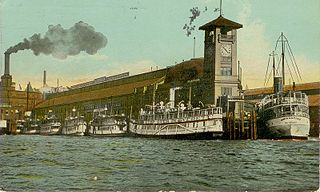
The Puget Sound mosquito fleet was a multitude of private transportation companies running smaller passenger and freight boats on Puget Sound and nearby waterways and rivers. This large group of steamers and sternwheelers plied the waters of Puget Sound, stopping at every waterfront dock. The historical period defining the beginning and end of the mosquito fleet is ambiguous, but the peak of activity occurred between the First and Second World Wars.
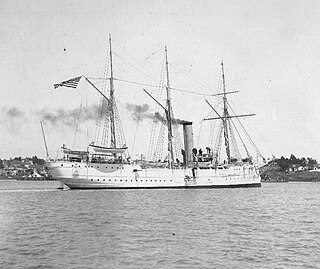
USS McCulloch, previously USRC McCulloch and USCGC McCulloch, was a ship that served as a United States Revenue Cutter Service cutter from 1897 to 1915, as a United States Coast Guard Cutter from 1915 to 1917, and as a United States Navy patrol vessel in 1917. She saw combat during the Spanish–American War during the Battle of Manila Bay and patrolled off the United States West Coast during World War I. In peacetime, she saw extensive service in the waters off the U.S. West Coast. She sank in 1917 after colliding with another steamer.

Wapama, also known as Tongass, was a vessel last located in Richmond, California. She was the last surviving example of some 225 wooden steam schooners that served the lumber trade and other coastal services along the Pacific Coast of the United States. She was managed by the National Park Service at San Francisco Maritime National Historical Park until dismantled in August 2013.

Active was a survey ship that served in the United States Coast Survey, a predecessor of the United States Coast and Geodetic Survey, from 1852 to 1861. Active served on the U.S. West Coast. She conducted the Coast Survey's first reconnaissance from San Francisco, California, to San Diego, California, in 1852. Active sometimes stepped outside her normal Coast Survey duties to support U.S. military operations, serving as a troop transport and dispatch boat during various wars with Native Americans and during the San Juan Islands "Pig War" with the United Kingdom in 1859. She also rushed Union troops to Los Angeles, California, in 1861 during the early stages of the American Civil War.

The SS Superior City was considered a pioneer vessel at her launching in 1898. She was the largest vessel ever built on freshwater at that time. She sailed the Great Lakes for twenty-two years until she sank after a collision in 1920 with the steamer Willis L. King in Whitefish Bay of Lake Superior that resulted in the loss of 29 lives. Controversy was immediate over the collision. It was subsequently ruled that the captains of both ships failed to follow the “rules-of-the-road”. Controversy started again in 1988 when the Great Lakes Shipwreck Historical Society produced a video called "Graveyard of the Great Lakes" that included extensive footage of the skeletons of the Superior City crew. The controversy continued as late as 1996 over artifacts removed from her wreck. She is now a protected shipwreck in the Whitefish Point Underwater Preserve.
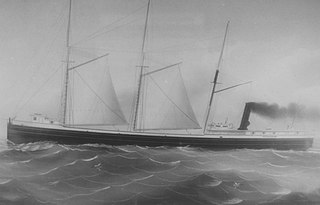
The John M. Osborn was a wooden steam barge that sank in Lake Superior in 1884 with the loss of five lives. The Osborn was just 2 years old when the larger, steel-hulled Alberta, which was called a "steel monster" and "terror of the lakes", rammed her. The wreck of the Osborn was discovered 100 years after her sinking. The wreck was illegally salvaged in the 1980s. Many of Osborn's artifacts became the property of the State of Michigan after they were seized from Great Lakes Shipwreck Museum. The State allows the museum to display the artifacts as a loan. The wreck of the Osborn is now protected by the Whitefish Point Underwater Preserve as part of an underwater museum.

SS La Bourgogne was a French ocean liner, which sank in a collision off the coast of Nova Scotia in July 1898, with the loss of 549 lives. At the time this sinking was infamous, because only 13% of the passengers survived, while 48% of the crew did. Before the sinking, in 1886, the ship had set a new record for the fastest Atlantic crossing by a postal steamer.

SS Columbia (1880–1907) was a cargo and passenger steamship that was owned by the Oregon Railway and Navigation Company and later the San Francisco and Portland Steamship Company. Columbia was constructed in 1880 by the John Roach & Sons shipyard in Chester, Pennsylvania for the Oregon Railway and Navigation Company.
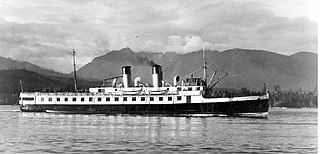
Lady Cynthia was a steel-hulled passenger ship converted from a minesweeper,, which served in the coastal waters of British Columbia from 1925 to 1957. Lady Cynthia was a sistership to Lady Cecilia, also a converted minesweeper. The ship was generally referred to as the Cynthia while in service.
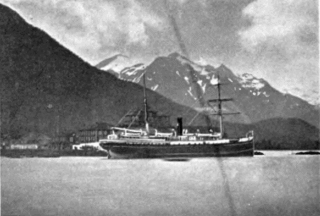
SS George W. Elder (1874–1935) was a passenger/cargo ship. Originally a U.S. east coast steamer, she was built by John Roach & Sons in Chester, Pennsylvania. The George W. Elder became a west coast steamer in 1876 and served with the Oregon Steamship Company, Oregon Railroad and Navigation Company, San Francisco and Portland Steamship Company and the North Pacific Steamship Company. In 1907, the George W. Elder helped to rescue the survivors of her former running mate Columbia. The last owners of the George W. Elder were a Chilean firm which operated her under the name America. She operated the Chilean Coast under this guise until 1935, when she was finally scrapped. The location of her scrapping remains unknown.

SS San Juan was a passenger steamship owned by the Los Angeles and San Francisco Navigation Company. Previously, she was owned by the Pacific Mail Steamship Company and White Flyer Line. At the age of 47 years, San Juan was involved in a collision with the steel-hulled oil tanker S.C.T. Dodd. Because of her aged iron hull, San Juan was fatally damaged in the collision and sank three minutes later, killing 65 people. The loss of San Juan was strikingly similar to the loss of Columbia.
The North Pacific Steamship Company was a shipping company operating along the west coast of the United States and to South America during the late 19th century and early 20th century.

Onondaga was a steam cargo ship built in 1905 by William Cramp & Sons of Philadelphia for Clyde Steamship Company with intention of operating on their East Coast and West Indies routes.
Shortly before dawn on May 6, 1953, just north of the Strait of Dover, the USNS Haiti Victory collided with the overnight ferry TSS Duke of York. The Duke of York was westbound on its regular run between the Hook of Holland (Rotterdam) and Harwich, England. Haiti Victory was northbound, heading for Bremerhaven, Germany. The Haiti Victory sliced into Duke of York's bow, just forward of its bridge. The bow later broke off and sank. Eight of the Duke of York's passengers died; at least nine others were injured.



